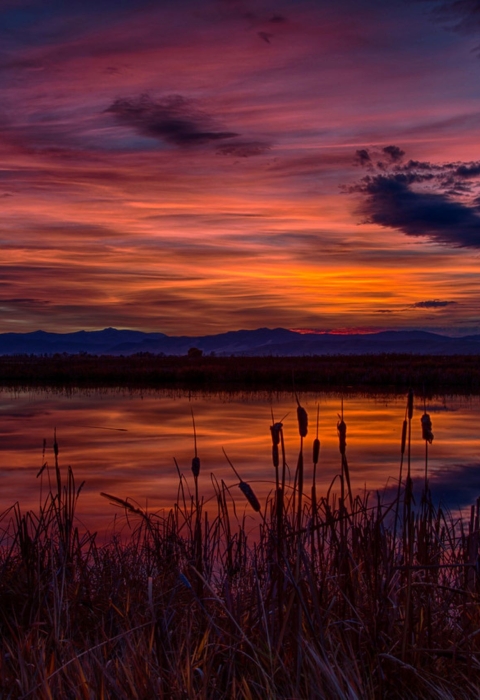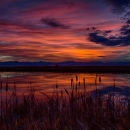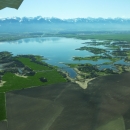Visit Us
Access to Ninepipe National Wildlife Refuge changes throughout the year to accommodate nesting birds, the purpose for which the Refuge was established. Driving on Ninepipe Road, which crosses the dam that creates Ninepipe Reservoir, is available year-round. This road travels along the deeper side of the Reservoir. Walking is limited on the Refuge as water comprises over 80% of the area and much of the land is very wet during the spring. A short interpretive trail can be found at the Ninepipe Watchable Wildlife Viewing Area located off Highway 93.
| March 1 - July 14 | Areas along the north part of the Refuge, portion just south of Wildlife Viewing Site, open to access. All other areas, including portions of the ice, closed to all public use. |
| July 15 - to Start of Waterfowl Season | Entire Refuge open (except for offshore islands) |
| Waterfowl Season | Entire Refuge closed to public access |
| End of Waterfowl Season - end February | Entire Refuge open |
Please be aware of special closures due to low water, fire danger, safety concerns, and other unforeseen events. Comply with all posted signs.
Under a cooperative agreement with the Confederated Salish and Kootenai Tribes, the general recreation fee is waived for non-consumptive use of Ninepipe National Wildlife Refuge by non-members of the Tribes.
Weather Conditions
The portion of the Flathead Valley in which the Range is located has a microclimate usually characterized by relatively mild winter temperatures and little wind. Snow cover melts quickly at lower elevations. Summer temperatures seldom exceed 100 degrees Fahrenheit and because of low humidity, nights can be fairly cool. Freezing conditions generally occur from late November through March. Precipitation averages about 15 inches annually at the Refuge. Low precipitation along with summer thunderstorms can lead to naturally occurring wildfires.
Trails
Enjoy a walk on the short interpretive trail at the Wildlife Viewing Site and learn about Refuge habitats and the animals that live there. With the Mission Mountains to the east providing a dramatic backdrop, look for flocks of Canada geese, great blue heron rookeries, bald eagle and osprey nests, Forster’s and Caspian tern colonies, and much more.
Related Documents
Other Facilities in the Complex
Ninepipe National Wildlife Refuge is managed by the Northwest Montana Wetland Management District as part of the Western Montana National Wildlife Refuge Complex. A Complex is an administrative grouping of two or more refuges, wildlife management areas, or other refuge conservation areas that are managed from a central location. Refuges are grouped into complexes because they occur in a similar ecological region, such as a watershed or specific habitat type, and have a related purpose and management needs.
For the Western Montana National Wildlife Refuge Complex, the project leader is stationed at Benton Lake National Wildlife Refuge and oversees general management of the Complex. Refuge managers oversee the operations at specific refuges. Supporting staff, composed of administrative, law enforcement, refuge manager, biological, fire, visitor services, and maintenance professionals support all refuges within the complex.
The District headquarters is located at PO Box 547 Ronan, MT, 59864 or 406-750-8242.
The Complex headquarters is located at Benton Lake National Wildlife Refuge, 922 Bootlegger Trail, Great Falls MT 59404.
The refuges in the Western Montana National Wildlife Refuge Complex include:
Rules and Policies
Our number one priority at Ninepipe National Wildlife Refuge is the wildlife and their habitat. But we welcome the opportunity to share these resources with you. Therefore, we have a number of rules and regulations that help protect the resources as well as visitors. Please help by following all rules and regulations.
The refuge has limited access during breeding and hunting seasons to allow birds to nest and rest. Off-shore islands are closed to public use at all times in order to limit disturbance to migratory birds. Please be aware of special closures due to low water, fire danger, safety concerns, and other unforeseen events. Comply with all posted signs.
General Information:
- Wading and walking are the only means to access the Refuge when off road.
- Cross country skis and ice skates are allowed during the winter season, ice conditions permitting.
- Off road vehicle travel, to include vehicle travel on ice, is prohibited. Be considerate and do not block roads or gates.
- All pets must be on a leash and under control at all times when outside of vehicles. Be considerate and clean up after your pet.
- Horses are not permitted on the Refuge.
Ninepipe National Wildlife Refuge is closed to all public use from sunset to sunrise. Vehicles may travel along Ninepipe Road across the dam but do not stop when the Refuge is closed. Leaving personal property, including ice fishing shelters and vehicles, is not permitted between sunset and sunrise. Neither fires nor fireworks are permitted on the Refuge.
Locations
Ninepipe National Wildlife Refuge is open daily during daylight hours (closes to all public use at night) with restrictions to access as follows:
| March 1 - July 14 | Areas along the north part of the Refuge, portion just south of Wildlife Viewing Site, open to access. All other areas, including portions of the ice, closed to all public use. |
| July 15 - to Start of Waterfowl Season | Entire Refuge open (except for offshore islands) |
| Waterfowl Season | Entire Refuge closed to public access |
| End of Waterfowl Season - end February | Entire Refuge open |
Ninepipe National Wildlife Refuge is located on the Flathead Indian Reservation with its northeast corner framed by Highway 93 (eastern boundary) and Highway 212 (northern boundary). To reach the Watchable Wildlife Viewing Area, located off Highway 93, drive 6 miles south of Ronan (1 mile south of the junction with Highway 212). Or from Missoula, take Highway 93 north about 50 miles. The entrance to the site is on the west side of the road.
The other main access point is Ninepipe Road, which is located across the dam on the northwestern edge of the Refuge, off Highway 212 just about 2 miles from the junction with Highway 93. A few parking areas and access points are located around the perimeter of the Refuge.



